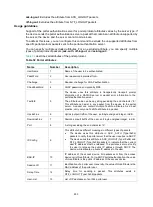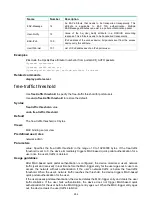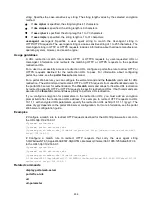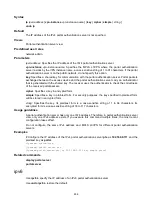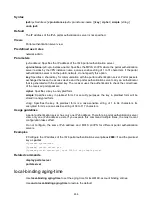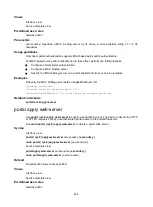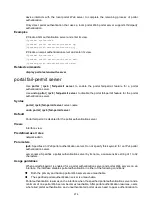
261
Usage guidelines
This feature enables the device to act as a local MAC binding server to provide local MAC-trigger
authentication for local portal users.
After a user passes portal authentication for the first time, the access device (local MAC binding
server) generates a local MAC binding entry for the user. The local MAC binding entry records the
MAC address and authentication information (username and password) of the user. Then, the user
can be automatically connected to the network without manual authentication for subsequent
network access attempts.
Examples
# Enable local MAC-trigger authentication for MAC binding server
mts
.
<Sysname> system-view
[Sysname] portal mac-trigger-server mts
[Sysname-portal-mac-trigger-server-mts] local-binding enable
Related commands
display mac-trigger-server
local-binding aging-time
logon-page bind
Use
logon-page bind
to bind an SSID or endpoint type to an authentication page file.
Use
undo logon-page bind
to unbind the SSID or endpoint type from the authentication page file.
Syntax
logon-page bind
{
device-type type-name
|
ssid ssid-name
} *
file
file-name
undo logon-page bind
{
all
|
device-type type-name
|
ssid ssid-name
} *
Default
No SSID or endpoint type is bound to an authentication page file.
Views
Local portal Web server view
Predefined user roles
network-admin
Parameters
all
: Specifies all SSIDs or endpoint types.
device-type type-name
: Specifies an endpoint type, a case-sensitive string of 1 to 127 characters.
The specified endpoint type must have been predefined on the device. Otherwise, the bound
authentication page file does not take effect.
ssid ssidname
: Specifies an SSID by its name, a case-insensitive string of 1 to 32 characters. An
SSID string can contain letters, digits, and spaces, but the start and end characters cannot be
spaces. An SSID string cannot be
f
,
fi
,
fil
, or
file
.
file file-name
: Specifies an authentication page file by the file name (without the file storage
directory). A file name is a string of 1 to 91 characters, and can contain letters, digits, and
underscores (_). You must edit the authentication pages, compress them to a .zip file, and then
upload the file to the root directory of the storage medium of the device.
Summary of Contents for FlexNetwork MSR Series
Page 1005: ...987 ...







